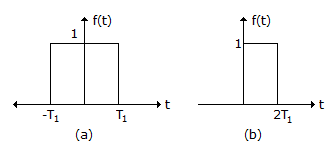ECE :: Signals and Systems
-
Assertion (A): Standard deviation is the abscissa of a point of inflection on the probability curve.
Reason (R): The equation for probability curve is

-
If f(t) and F(jω) form a transform pair, then as per symmetry in Fourier transforms
-
The theoretical power of white noise is
-
If Sn is the power associated with each frequency component and S(f) is the sum of all these powers, normalised power spectral density is
-
Assertion (A): When a function f(t) is represented as exponential Fourier series, the set of complex coefficients Fn is called frequency spectrum of f(t)
Reason (R): Frequency spectrum is also called line spectrum.
-
For the signal in the given figure the Fourier transform is
 Then the Fourier transform of the signal in the given figure
Then the Fourier transform of the signal in the given figure
-
Let x(t) ↔ X(jω) be F.T pair. The Fourier transform of the signal x(5t - 3) in terms of X(jω) is given as


 Whatsapp
Whatsapp
 Facebook
Facebook



















